There’s nothing like that new car-manual smell. Breath deep the scent of fresh paper and glue as you settle down with a beefy tome of intricate instructions all about your new car.
Better cancel your weekend plans.
Don’t dare drive your new car, not until you’ve read all 150 pages of the Infotainment Instruction Manual. Spoiler: it’s all info and no entertainment.
There came a point, in the not-too-distant past, when cars started shipping with not one, but two big manuals in the glovebox.
The first was your basic owner’s manual, a light read with generally good but obvious advice covering topics like: where does the fuel go, and how to use turn signals?
The second manual, the Infotainment Manual — also known as the Quick Start Guide (ha!) or the MeTouchPro2000 Operating Encyclopedia — is a newer phenomenon.
Worryingly, this second manual has been getting larger and larger in recent years as in-car infotainment systems become increasingly complex.
Drivers of all types of cars, in all price brackets, face longer and steeper learning curves than ever before. This issue of complexity is not unique to any particular automaker, although not all infotainment systems are created equal. They’re all different, which is part of the problem.
When exactly infotainment systems became complex enough to warrant their own separate manuals, I don’t know. I’ve got a 2001 BMW. It came with several booklets in the glovebox, including a little novella instructing owners on the finer points of the CD-ROM based navigation system.
You’ve almost got to pity the car companies — almost. They can’t win here. Buyers say they want more features, and have shown they’re willing to splash out extra cash to get them.
In a focus group, you’d probably say yes, a feature that reads aloud your work e-mails during your morning commute is useful. In practice though, are you really going to learn how to use it and troubleshoot connectivity issues? Or, will you probably just listen to the radio?
Martin Landgraf-Dietz is on the front-lines of the Infotainment Wars. His job, as a user experience designer at Audi, is to make all this in-car tech easy to use.
“We want to make it intuitive, but it’s not possible to do 100 per cent,” he said. “We talked to our customers in the U.S., and they’re willing to learn, but only a certain amount.”
“We tried to make [the infotainment system] similar to a smartphone interface so it’s familiar to customers . . . We’re making the system the same across all models. We have a lot of videos online to help people, and we work with our dealers to explain it better to customers,” he said.
Most drivers only use six of the hundreds of functions available on infotainment systems, according to one study by Harman International. The problem is that drivers don’t all use the same six functions.
Exacerbating the issue is the fact that some customers like touchscreens, others like buttons, while others prefer voice control.
So, on top of the hundreds of functions, most of which you’ll never use, you’ve also got three ways to control each of them.
No wonder infotainment manuals are becoming as thick as War and Peace.
“For the voice recognition,” Landgraf-Dietz said, “some [customers] say the system talks too much. Others say they want it to read out everything on the screen. In general, I can see that people don’t use a lot of functions, but if we remove some of them, customers might say they miss it and we need to bring it back. It’s not easy.”
At least for now, there’s no getting around the longer learning curve. But, there are easier ways to ascend it than leafing through the textbook in the glovebox.
As Landgraf-Dietz said, Audi and most other automakers are creating web videos to teach owners about specific functions.
The videos can often be found on automakers’ own websites, and on YouTube. It’s not ideal, but better than giving your Sunday up to reading through a car manual.
Besides, it’s not just cars that have longer learning curves these days.
Your smart fridge and internet-connected doorbell also have longer, steeper learning curves than their analog counterparts. With every major new version of iOS, you’ve got to re-learn how to use your iPhone.
Go into any Apple store and you’ll see a calendar of classes teaching customers how to use their new gadgets. After you take the iPad Basics class you can graduate to iPad Intermediate. At the Expert level you get a PhD in Couch-Based ’Net Surfing.
We’re trading extra functionality — stuff meant to make our lives less painful — for the initial pain of learning how to use these new functions.
One day, in the not-too-distant future, the infotainment manual could be the only manual left. Self-driving smart cars will drive themselves and re-charge automatically, taking themselves to the dealership for maintenance as needed.
Meanwhile, you’ll be left alone inside with the manual trying to figure out how to pair your Google glasses with the in-car Netflix app.
Good luck!









